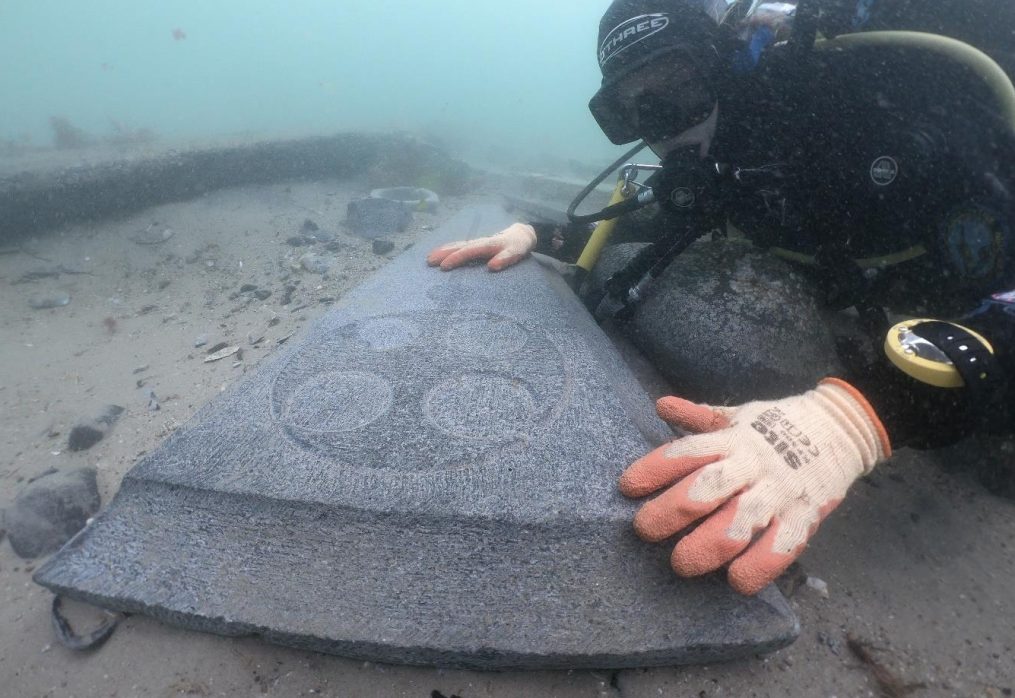Huge Christian Grave Slabs Recovered From 13th-Century Shipwreck
Maritime archaeologists have recovered two large grave slabs from a historic 13th-century shipwreck.
The stricken medieval vessel—known as the “Mortar Wreck”—lies at the bottom of the sea off the coast of the Isle of Purbeck, a peninsula in the county of Dorset, southern England.
The ship sank around 800 years ago, making it the oldest known in English waters. At the time, it was carrying several items of cargo, including the grave slabs and a number of grinding mortars, hence the name.
The slabs and mortars are all made from Purbeck Marble—a fossil-containing limestone found only on the peninsula that has been quarried for decorative purposes since at least antiquity.

Bournemouth University
A team of divers and maritime archaeologists led by Tom Cousins with Bournemouth University, located in Dorset, managed to successfully recover the grave slabs from the wreck on June 4. In total, the operation lasted around two hours, with the slabs being lifted from a depth of around 23 feet.
One of the slabs is exceptionally well-preserved and completely intact, measuring around 5 feet in length while weighing an estimated 154 pounds. The other slab is significantly larger but has split up into two pieces, which have a combined length of more than 6 feet and a total weight of roughly 440 pounds.
Both of the slabs have carvings of Christian crosses and would have been used as coffin lids or crypt monuments for high-status individuals of the clergy.
“They would have either topped a coffin or been laid horizontally over the remains like a ledger stone,” Cousins told Newsweek. “As Purbeck Marble doesn’t do well outside, they would have been placed within the church, cathedral or monastery, etcetera.”
“The wreck went down in the height of the Purbeck stone industry and the grave slabs we have here were a very popular monument for bishops and archbishops across all the cathedrals and monasteries in England at the time,” Cousins said in a press release.
Grave slabs made from Purbeck Marble are not necessarily uncommon—more than 800 can be found in churches across England, as well as a few in Ireland and parts of France.
“But most of these are out of context and displayed as curiosities in churches. The rarity [of the discovery] is the material, which only exists in our small corner of Dorset,” Cousins told Newsweek.
The site of the Mortar Wreck was first discovered in 1982, but at the time the remains of the vessel were assumed to be a pile of rubble on the seabed. It was not until 2019 that Cousins and a team from Bournemouth University conducted dives at the site, revealing its true nature.
“The archaeological significance is the ship as a whole and what it can tell us about trade and lives in the 13th century, as well as ship technology,” Cousins told Newsweek.
The recovered grave slabs will now be desalinated and conserved by the Bournemouth team until they can be on public display, alongside other artifacts from the wreck, at a museum set to open next year.
Do you have a tip on a science story that Newsweek should be covering? Do you have a question about archaeology? Let us know via science@newsweek.com.
Uncommon Knowledge
Newsweek is committed to challenging conventional wisdom and finding connections in the search for common ground.
Newsweek is committed to challenging conventional wisdom and finding connections in the search for common ground.
